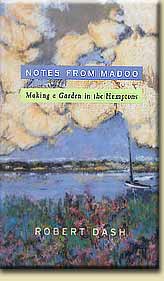 |
||||
|
"To my way of seeing, a garden is not a succession of small rooms
or little effects but one large tableau, whose elements are inextricably linked to the accomplishment of the entire garden. . ." |
||||
|
We give names to our children and pets because they are dear to us. Why not to our gardens? Robert Dash did name the nearly two acres of land that he gardens at the far end of Long Island. He calls it Madoo, old Scots for "My Dove," the traditional symbol of peace and contentment. Dash is a painter and writer. The garden he keeps shows the influence of both. He sees his garden space as a canvas. His plantings are elements of shape, mass, and color that "are inextricably linked to the accomplishment of the entire garden." In his book, he chooses the words he uses to describe each plant with the same care as novelist creating a principal character. Like a reporter interviewing celebrities, Dash punctuates his book with more than two dozen "Plant Portraits." Like investigative interviews, Dash's portraits reveal family secrets that the plants would rather not have told. His portrait of the basil begins with praise: "I grow the small-leafed, diminutive, bushy basil that mounds to the ground, is tidy in appearance, and is luminous green flushed with lime. It glows as if from some wattage within." But then it turns nasty when he gets to the bushy basil's relative, the opal basil: "It is no good in the border and useless in the kitchen. It is an unpleasantly colored plant, as its purple does nothing but make interruptions or holes in a mixed planting." Apart from the plant portraits and gardeb musings offered in his book, there is also an online collection of the bi-weekly garden columns that Dash wrote for the East Hampton (New York) Star. To read his newspaper columns, go to the paper's archives and search for "dash and garden" Robert Dash is a founding patron of The Garden Conservancy, an organization established in 1989 to preserve exceptional American gardens and to open them to the public. Perhaps because of his association with the Garden Conservancy, he decided open to his garden to the public in 1993. Shortly after opening his garden, Dash set up an irrevocable trust incorporating his garden as the Madoo Conservancy to forever preserve the garden for the benefit of the community. Dash plans to continue to live on the grounds and to retain "responsibility for the artistic development of Madoo." But after his death, his residence will go into an endowment to support the garden. Much of what Dash is doing now parallels what Henry Shaw, St. Louis businessman and founder of the Missouri Botanical Garden, did more than a century ago to preserve and protect the garden he built. Thirty years before he died, he opened his garden to the public, the first private garden in America opened to the public. When he died in 1889, his will said that the garden should be accessible to the general public and should "forever kept up and maintained for the cultivation and propagation of plants, flowers, fruit, and forest trees, . . . and devoted to the science of Botany, Horticulture, and allied objects . . . . To accomplish his purposes, Shaw, like Dash, set up a board of trustees to inherit the garden and to guide its future. To secure its financial future, Shaw turned over a sizable part of his fortune, estimated to be from $40 to $50 million in today's dollars, to the garden and to advance the study of botany. Madoo Conservancy has similar aims and uses like methods. Let's hope they will work again. |
|||
